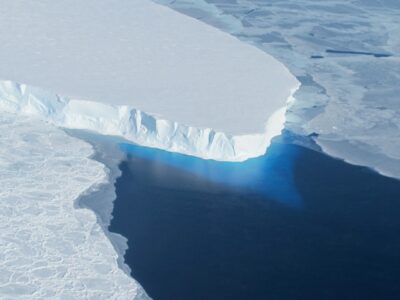The theme of this year’s UN World Oceans Day, celebrated on June 8, is Awaken New Depths. The topic speaks to the enormous complexity of the water surrounding us and hints at its many unknown yet vital functions.
One of the ocean’s most critical roles invites questions Lamont researchers are trying to address, namely: How much carbon does the ocean hold? And how do we begin to take measurements of something so vast? Professor of Earth and Environmental Sciences Galen McKinley and her research group have been charting the course to understand how the ocean absorbs carbon and fights climate change in the process. McKinley and her group are based at Lamont-Doherty Earth Observatory (LDEO), which is part of the Columbia Climate School.

Our ocean is a natural carbon sink, absorbing about 25% of carbon dioxide (CO2) emissions from the atmosphere every year. Coupled with the land biosphere that also takes up about 25% of carbon dioxide emissions, we have two natural processes that currently remove around half of the annual carbon dioxide emissions from the atmosphere, McKinley explained.
“If we use a moderate CO2 price of $100 per metric ton,” McKinley said, “then the ocean performs $1 trillion of climate mitigation services each decade, while the land biosphere provides another $1 trillion.”
But what happens if these numbers change? “If the ocean and land biosphere sinks start taking up less carbon, we have a bigger job of mitigating emissions in order to limit climate change. Or if we are lucky and they start taking out more carbon, it would help us out,” McKinley said. That’s why she believes being able to measure the sinks and any fluctuations is critical for understanding how climate change is going to evolve in the future.
In the Q&A below, McKinley discusses how she and her colleagues have been working to calculate how much carbon the ocean stores, as well as where the uncertainties still lie.
This interview has been edited for length and clarity.
Can you give some background on your current research on the ocean carbon sink?
In the 1950s, Taro Takahashi here at Lamont started figuring out how we could develop instruments that could go on a ship and observe the partial pressure of CO2 [pCO2], which tells us how much carbon dioxide is in the surface ocean. Then in the late 1990s, Takahashi released the first full global estimate of these air-sea CO2 fluxes, which he updated several times in the subsequent decade. He also shared his innovations with scientists around the world. Others have been measuring pCO2 as well, with similar automated instruments, and collating these data into a freely available database.
Since my group came to LDEO in 2017, we have been using machine learning to extrapolate these sparse pCO2 data to monthly estimates covering the global oceans. This work can be seen as an evolution of the work that Takahashi began. From these pCO2 fields, we estimate the air-sea CO2 exchange. The sum of all these fluxes across the globe is the ocean carbon sink. Quantifying this sink monthly allows us to track the sink as it evolves over time.
In the past couple of years, my group has developed two different machine learning–based approaches that give us monthly measurements—in one case including data starting from the 1950s and the other case from the 1980s—to the present. Because of this work and the push in our field to be more reproducible and transparent, we’ve created a new website that provides explanations about our methods, links to papers, the source code and the datasets themselves.
Every year, we’re also contributing to the Global Carbon Budget, which is released in late fall, right before the Conference of the Parties (COP) of the United Nations Framework Convention on Climate Change. The Global Carbon Budget is an effort by hundreds of scientists to quantify the human-caused emissions and the natural sinks in the land and ocean that together determine the atmospheric CO2 concentration. Rising atmospheric CO2 is the primary driver of climate change.

How are the data on ocean carbon collected? And how does the machine-learning approach then quantify these measurements on a global scale?
As a ship goes across the ocean, water comes in through an intake pipe. A small amount of that water is taken into an instrument that measures the pCO2. Gases with precisely known CO2 concentrations are carried with the instrument so that instruments can be calibrated frequently. The data is saved and then downloaded when the ship comes to port. These observations are collected and checked for quality, and then released in regularly updated data sets.
These instruments can be used autonomously on container, supply or cruise ships. You don’t have to have a scientist babysitting the instrument as it goes across the ocean. Using such “volunteer observing” ships is one way oceanographers increasingly use automated approaches to get better coverage of the vast and variable ocean. Every year we get on the order of 1 to 2% coverage of the global ocean in pCO2.
We then use machine learning models that combine these measurements with related observations, such as global sea surface temperatures collected by satellites, to estimate the pCO2 at every point across the global ocean.
How much do these numbers fluctuate from year to year?
We know that as the atmospheric carbon concentration goes up, as it does year upon year, that continues to drive carbon into the ocean. The ocean sink grows and grows, which is definitely seen in the data sets.
There are also interesting signals of variability that are less well understood. There are newly appearing phenomena such as marine heat waves that impact the ocean carbon sink, and we are working to understand these impacts in detail.
Looking ahead, how can these data be used to address climate change?
The only way to effectively address climate change is to dramatically cut our emissions of CO2, primarily due to the burning of fossil fuels. Courageous efforts in mitigation are now being made by many people, governments and businesses. But what we are doing now is far from enough. These efforts must ramp up dramatically if we are going to keep climate change from getting to a dangerous and unrecoverable level.
In the coming century, managing the climate will mean managing the carbon cycle. The ocean and land biosphere are already removing half of our annual CO2 emissions. There are no other pathways through which globally significant amounts of CO2 are being removed from the atmosphere. Though we know this to be the case at the global scale, our ability to quantify precisely how much carbon goes into a particular patch of ocean or a specific stand of trees has very large uncertainties. We need to reduce these uncertainties so that our efforts to manage carbon can be far more efficient, and so that we can invest in the management practices that are most effective at removing carbon permanently from the atmosphere.
In the ocean, there is now a push to try to engineer additional sinks of carbon. There are many small companies getting significant investment dollars to develop engineered marine carbon-dioxide removal approaches. The capacity of these engineering approaches will—for at least many decades, if not forever—be far smaller than the ocean carbon sink that naturally occurs. If we are in the dark about what the ocean does naturally, we will never be able to know if engineered efforts are making any difference. We will never know if when we pay a company, they will really remove carbon from the atmosphere or if they are selling us a false promise. We must continue to measure, better understand and predict the ocean carbon sink.



